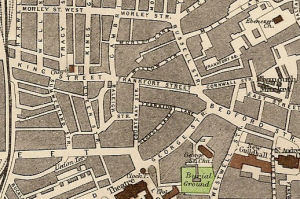|
OLD PLYMOUTH
. UK |
||
|
© Brian
Moseley, Plymouth Webpage created: April 25, 2021 Webpage updated: April 25, 2021 |
||
|
ROADS AND STREETS IN OLD PLYMOUTH - A-Z INDEX FRANKFORT STREET
On Benjamin Donn's map of Plymouth of 1765 the roadway that became Frankfort Street is seen running northwards from Frankfort Gate.
Frankfort Street ran westerly from the junction of Bedford Street and Russell Street to the junction of Courtenay Street, King Street, and Cambridge Street. As we can see from the above extract from Benjamin Donn's "Plan of the Town and Citadel of Plymouth", the Pig Market used to be just inside the Frankfort Gate. Prior to Bedford Street being developed this had become Frankfort Place. Outside of Frankfort Gate was the Globe Hotel, and the roadway to the right ran along what was then Stonehouse Lane to Stonehouse Bridge. This Lane later became King Street. As the number and size of carriages and wagons got larger and heavier so all the Town Gates began to cause obstructions to the traffic and were gradually removed. Frankfort Gate was demolished in 1783 and the area outside developed quickly after that, Frankfort Street being a logical name for the main road. The name commemorates the old Frankfort Gate that stood until 1783 as the western exit from the Town towards Plymouth Dock. The origin of the name "Frankfort" is not yet known. There is no evidence to support the suggestion that the fort at the gateway was under the command of a man named Frank. There is a reference in Worth's "Calendar of the Plymouth Municipal Records" to a deed which he summarizes as 'Frankfort gate house newly built, lately in the occupation of Thomas Gill, 1652'.By 1812 Frankfort Street had appeared but there was also a Frankfort Row, which Whitfeld states later formed part of Frankfort Street. Frankfort Street was almost completely destroyed during the Second World War, with only Leicester Harmsworth House, the brand new offices of the Western Morning News Company Limited, surviving. These are still standing in New George Street. For the Occupants of Frankfort Row and Frankfort Street in 1812 CLICK HERE. For the Occupants of Frankfort Street in 1852 CLICK HERE.
|
||

